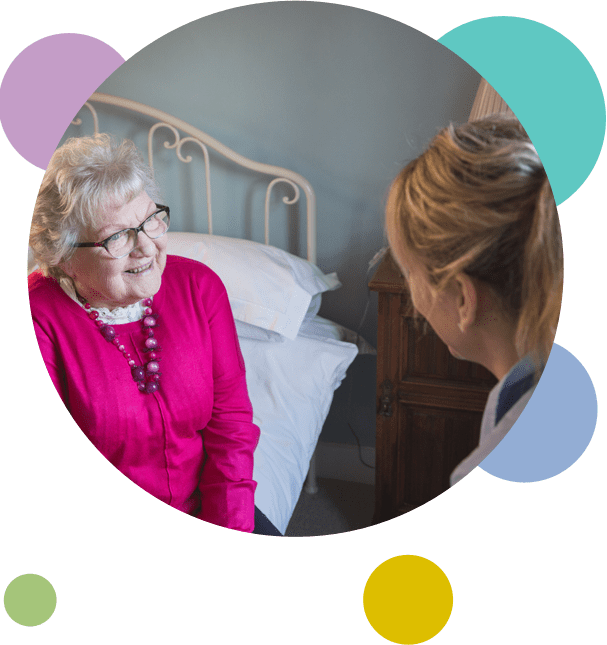What are arthritis nodules?
Arthritis nodules are round or elongated lumps that develop under the skin of people with osteoarthritis or rheumatoid arthritis. While these lumps are often harmless, in some cases they may be painful or cause other complications.
Most arthritis nodules don’t give any trouble and don’t require any intervention. But if you suddenly experience new lumps under your skin or your existing nodules become painful or limit your movement, then you may want to discuss this with your GP.

What are the different types of arthritis nodules?
Arthritis nodules are firm or dough-like lumps of varying sizes that develop closely under the skin of people with osteoarthritis or rheumatoid arthritis. These bumps may be as large as a walnut or as small as a pea. Some are bumpy while others are firm, but as long as there is no underlying inflammation, they are not usually painful.
The two most common forms of arthritis can cause different types of arthritis nodules.
Osteoarthritis: heberden’s nodes
Heberden’s nodes are small, bony growths that occur on the affected joints of people with osteoarthritis.
Cartilage is a strong and flexible connective tissue that protects the ends of your bones from rubbing together. Osteoarthritis causes this cartilage to slowly break down over time. As this cartilage breaks down, your bones come into direct contact with each other and start to wear down.
Your body responds to this breakdown of cartilage by growing new bone. Unfortunately, this new bone may grow abnormally and form a lump that sticks out from the side of your joints. This lump is called a Heberden node.
Heberden’s nodes are often a sign of advanced osteoarthritis since they only develop after the joint has received considerable wear-and-tear. Other signs and symptoms of osteoarthritis include:
- Pain, swelling or stiffness.
- Stiff or enlarged fingers
- Lumps on finger joints or at the end of your fingers
- Loss of motion
Risk factors
There are several factors that can contribute to Herbeden’s nodes developing, including:
- Hereditary conditions that affect the joints
- Long-term repetitive stress to the fingers
- Increasing age, especially being over 65
- Gender – women are 10 times more likely than men to develop osteoarthritis
- Previous finger injuries or surgeries
- Genetic defects in the cartilage or fingers
- Being overweight
Rheumatoid arthritis nodules
Rheumatoid arthritis nodules are firm lumps that occur under the skin of people with rheumatoid arthritis (RA).
What does a rheumatoid arthritis nodule look like? They can be either smooth or bumpy and they can vary in size, shape and location on the body. They often form on overexposed joints such as fingers, knuckles and elbows, although they can appear anywhere in the body.
These nodes are usually harmless and painless. A very large nodule may press on nearby nerves, causing pain and discomfort and limit the person’s ability to move their hands, feet or more. Nodules may become tender to the touch and this often occurs when a person is experiencing a flare-up of their RA.
Rheumatoid nodules don’t always require treatment. As treatments improve and the effects of rheumatoid arthritis become less severe, nodules have become smaller and rarer.
If your RA nodules are causing you discomfort or distress or are limiting your mobility, your GP can recommend treatments that can remove the nodules or make them smaller.
Risk factors
There are several factors that put you at greater risk for developing rheumatoid arthritis nodules including:
- The severity of your RA and the length of your condition
- Being CCP positive
- Being prone to other RA complications
- Smoking
Reducing discomfort and relieving stiffness
There are currently no treatments available to cure Heberden’s nodes or rheumatoid arthritis nodules. There are several measures and lifestyle changes that can be undertaken to reduce discomfort and relieve stiffness, including:
- Enjoying regular exercise
- Eating a healthy and balanced diet
- Painkillers such as paracetamol and ibuprofen can help reduce pain and manage symptoms
- Supportive therapies such as manual therapy, assistive devices and transcutaneous electrical nerve stimulation (TENS)
- Losing weight if necessary
How The Good Care Group can help
If you are living with arthritis and it is affecting your ability to live life on your terms, help is available in the form of live-in care. Our dedicated live-in carers are experienced in helping people with arthritis manage their condition and live happy and independent lives in the comfort of their own homes.
We have a dedicated team of in-house clinical experts. This includes our own in-house Occupational Therapist (OT) who works closely with healthcare professionals and our care teams. Our OT provides guidance and advice that enables people to live well in their own home with any equipment they may need. These experts lead, monitor and support our care teams to deliver best practice nurse-led care at home.
Whether it’s lending an ear over a cup of tea or helping you manage your medication, our competent and compassionate carers can provide support with any day-to-day tasks that you need to thrive independently.
To learn more about how our high-quality live-in care can help you, do not hesitate to contact us.
Talk to us about your care needs
To talk about your care needs, contact one of our friendly advisors. Calls from landlines are free.
